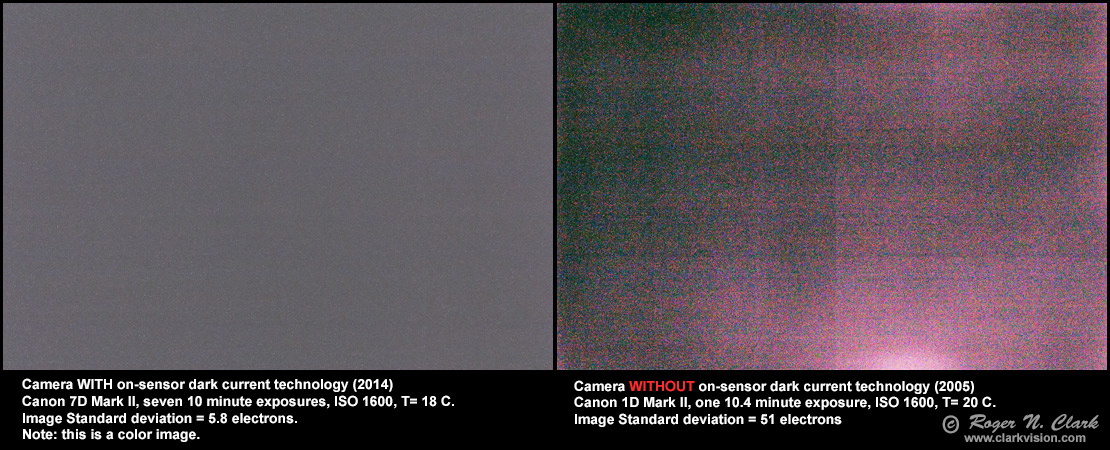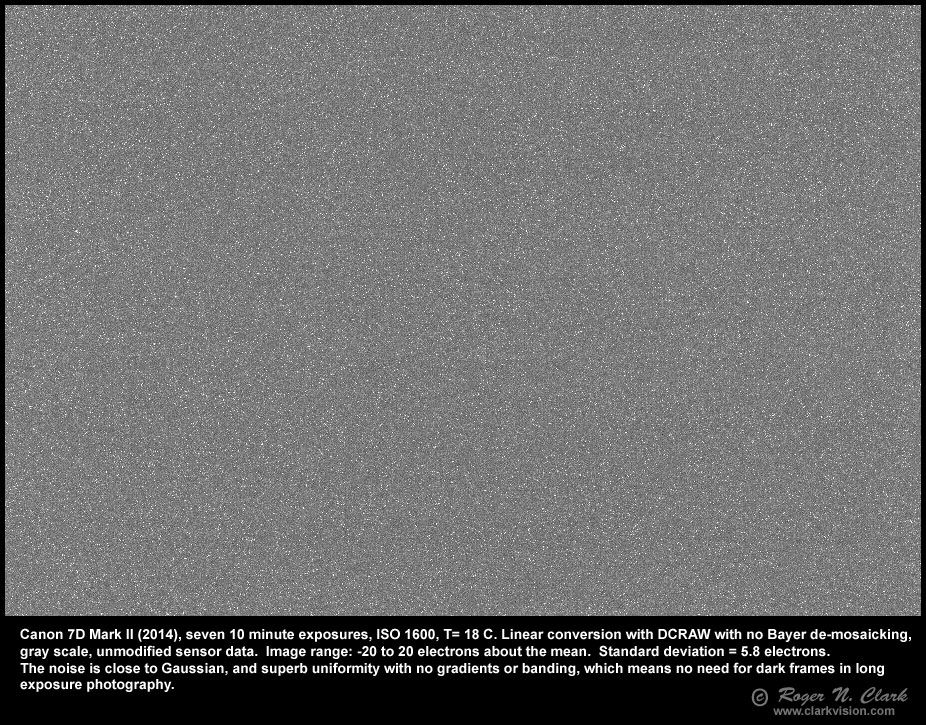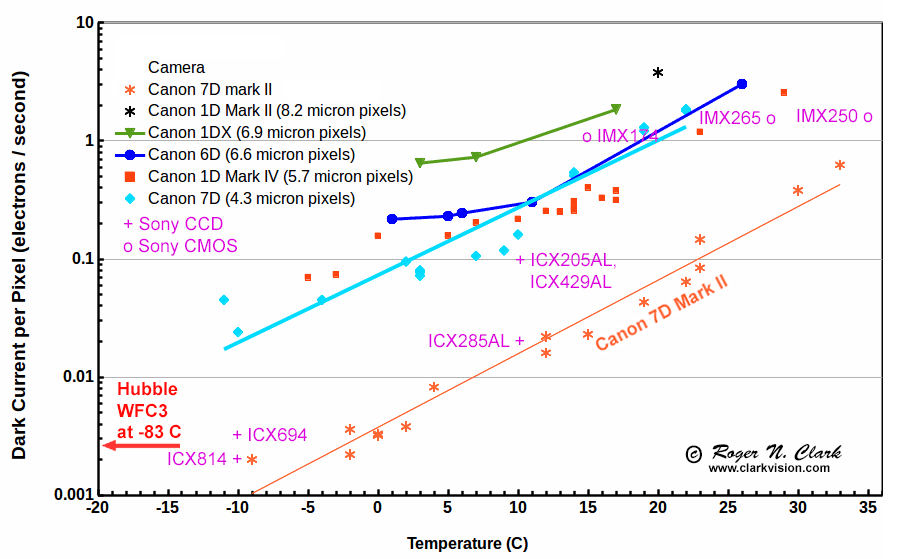ClarkVision.com
| Home | Galleries | Articles | Reviews | Best Gear | Science | New | About | Contact |
On-Sensor Dark Current Suppression Technology
Dark Frames Are No Longer Necessary
by Roger N. Clark
| Home | Galleries | Articles | Reviews | Best Gear | Science | New | About | Contact |
by Roger N. Clark
New technology in the pixel design of the sensors in digital cameras suppresses dark current. That means cleaner low light images. For astrophotographers, it means there is no longer a need to measure dark frames and subtract the dark signal in post processing.
The Night Photography Series:
Contents
Introduction
On Sensor Dark Current Suppression
Noise from Dark Current
CCD versus CMOS sensors
Which Cameras Have On-Sensor Dark Current Suppression Technology
Conclusions
References and Further Reading
Introduction
On long exposures with a digital cameras, electrons collect in the sensor due to thermal processes. This is called the thermal dark current. As with photon noise, the noise from dark current is the square root of the signal. One of the big contributions of noise in long exposure digital camera photography is noise from dark current. A significant problem in older sensors is the variation of the dark current from pixel to pixel creating fixed patterns. Dark current doubles every few degrees increase in temperature, so if there is a temperature gradient across the sensor, the dark current is not uniform. Electronics in the camera heating one side of the sensor produces varying dark current, leading to the commonly seen "amp glow" (Figure 1) in cameras without the new suppression technology. Fortunately, a new technology has been developed that suppresses the dark current eliminating amp glow and other patterns, such as banding.
The traditional method to deal with dark current effects is to measure dark frames separately and then subtract them in post processing. Camera manufactures added "long Exposure Noise Reduction" (LENR) to some cameras where after the camera makes the exposure, it closes the shutter, makes a second exposure and subtracts the dark frame from the exposed image. This doubles the amount of time needed to get an image.
First some facts about dark current.
Dark current doubles every few degrees increase in temperature. Typically, the doubling in CMOS sensors is every 5 to 6 degrees C. To be really precise with dark current subtraction, one needs the the dark current to be measured at the same temperature to within a fraction of a degree, and have the same temperature gradients. That is not practical.
In practice, making master dark frames for later subtraction is an approximation of the dark current that actually occurred during the imaging session as the temperatures are not always the same.
On the internet, some have argued that on sensor dark current suppression technology is just a software implementation. The camera would need to store many dozens of dark frames as a function of temperature and thermal gradient in order to effectively subtract the dark current. That idea is incorrect; Dark current suppression technology is part of the hardware electronics design of each pixel.

On Sensor Dark Current Suppression
On sensor dark current suppression is an electronics technology in each pixel that reduces dark current during the exposure. On Sensor Dark Current Suppression is not long Exposure Noise Reduction software. It is not software. It is not firmware. It is part of the hardware pixel design and is not software or firmware that can be turned on or off.
On sensor dark current suppression is a technology that reduces dark current during the exposure of your subject. There are several technologies and patents that are online describing the methods, and the technology is constantly being refined.
One example patent is from 2008:
APPARATUS AND METHOD FOR REDUCING DARK CURRENT WO 2008070180 A2
http://www.google.com/patents/WO2008070180A2?cl=en)
"An apparatus and method that reduces the dark current in each pixel of an image sensor, Where each pixel has a pinned photodiode. A negative potential barrier at the transfer gate of each pixel is raised when the photodiode is integrating (When the transfer gate is "off") to thereby eliminate dark current generation in this region. The potential barrier is applied via a "triple Well" transistor circuit structure that is capable of handling a strongly negative voltage. The circuit structure also serves as a conduit for conducting a strongly positive voltage to minimize the potential barrier during signal transfer and readout, thereby reducing image lag."
"1.3 Dark current suppression technology: Dark current is produced by microcrystalline defect or leakage current on CMOS and pixel charge is accumulated and increased in the case of long exposure or temperature rise, which causes CMOS to produce noise. For this reason, Canon Company adopts the architecture of "buried photodiode" to reduce probability of noise."
All this means that by suppressing dark current inside the pixel during the exposure on the subject, there is no problem of mismatching temperature of dark frames made at other times that may have been made at slightly different temperatures. This technology results in the amazing smoothness out-of-camera of the 5-minute dark frames shown Table 4 of my Canon 7D Mark II review, especially when compared to older cameras without the technology (Figure 1, right panel), and in the impressive smoothness of the 10-minute dark frame shown in Figure 2.

Noise from Dark Current
Noise from dark current is like photon shot noise: the noise is the square root of the signal.
See this reference for the random nature of the noise in dark current:
CCD Image Sensor Noise Sources,
On Semiconductor, 2016, AND9189/D
http://www.onsemi.com/pub_link/Collateral/AND9189-D.PDF
"Although the dark signal can be subtracted out, the shot noise
associated with this signal cannot. As in the case of photon shot noise,
the amount of dark current shot noise is equal to the square root of
the dark signal."
So dark current, DC, has the form:
signal from dark current = DC * time and the noise is (DC * time)0.5,
and DC is also a function of temperature (Figure 3).

So the dark current suppression technology blocks the DC * time component, leaving only the random noise. In order to make dark current suppression technology effective, manufacturers have had to refine manufacturing methods so that the sensors are very uniform, reducing pattern noise (banding).
Measuring dark frames has the main purpose of subtracting an offset caused by accumulating dark current level (DC * time) and pattern noise (including banding and amp glow) from the pixel to pixel variation in (DC * time), but dark current subtraction can't remove random noise.
Dark current suppression technology does the same thing, but in the pixel with the hardware architecture of the pixel, and does so during the exposure on your subject (while the camera is taking the picture). So there is no need for dark frame subtraction in cameras where the on sensor dark current suppression technology is well implemented (most recent camera models from the last few years). With such sensors, dark current is already subtracted DURING the light integration. There is no need to do it again in post processing (which will result in more noise).
If you subtract dark frames, the equation for random noise at the darkest signal level in the image is:
total noise in stack: = ( ( r2 + DC * t ) / N + ( DCF * t + r2 ) / M ) 0.5
where r = read noise, DC = sensor dark current, t = time, DCF = dark frame dark current, N = number of light frames, M = number of dark frames. If you measure the dark frames at the same temperature as the light frames, then DCF = DC.
The equation reduces to the noise is proportional to:
noise = ( 1 / N + 1 / M ) 0.5
Common in astrophotography is the take many exposure on the subject as one has time for, then fewer dark frames. For example, if you did 220 exposures on your subject (called "lights"), then N = 220 and if you did only 10 darks (M = 10), the noise in your image is proportional to sqrt ( 1 / 220 + 1 / 10 ) = 0.323. Skip the darks and the noise reduces to: sqrt ( 1 / 220 ) = 0.067, or 0.323 / 0.067 = 4.8 times better! How much is actually achieved is dependent on how much noise from the sky signal is present.
CCD versus CMOS sensors
The typical read noise in a CCD is on the order of 6 to 16 electrons. The best CMOS digital camera sensors are under 1 electron. Dark current in good CMOS sensors are under 0.02 electrons/second at 10C (circa 2014-2016). Compare that to the SBIG STF-8300C CCD camera, which has a dark current of 0.02 electrons/second at -10 C, and read noise of 8 electrons. Note the CCD must be run 20 degrees C colder to achieve the same performance as the best current DSLRs. At 8 electron read noise of the CCD, read noise is still a significant factor in faint signal detection. At read noise under 2 electrons, read noise becomes a non-issue. A 1 electron read noise versus 8 is a factor of 8 fainter detection in favor of the CMOS in short exposures. CCDs must be exposed longer than CMOS so that read noise will be less of a factor in the total noise from faint objects.
Which Cameras Have On-Sensor Dark Current Suppression Technology
On-sensor dark current suppression started to be introduced in camera models circa 2008 and has been refined ever since, with dark current levels being reduced, the suppression technology improved, and uniformity improved (less pattern noise issues like banding).
To test if your camera has on-sensor dark current suppression, make two exposures in a dim room with the lens cap on: one short, like 1/100 second and one long, like 10 minutes. Use ISO 1600 and be sure no light is entering the camera from the viewfinder.
Next convert the raw files from the above two exposures with the same settings. Adjust the black point so that the peak of the histogram is well separated from the left edge. One some cameras it is not possible to completely separate the histogram because low end data values are clipped.
Next use the levels tool, moving the right slider to the left to increase brightness. Do the same with both images. You can apply the levels tool multiple times to magnify the differences if desired. Look for patterns, like that shown in Figure 1, right panel. If you do not see any patterns in the long exposure image, you have a good sensor and likely do not need to subtract dark frames in your astrophotography.
Calibrating your images to photoelectrons. One first needs the gain. Gain for any modern digital camera can be estimated within about 10%. The max signal is about 2000 to 2100 electrons per square micron at ISO 100, or 2000/16 = 125 electrons at ISO 1600. So a camera with 4 micron pixels would have 4 * 4 * 125 =2000 electron range at ISO 1600. The 14-bit gain is then approximately 2000 electrons / 214= 0.12. In practice the digital range is a little less, more like 14000, so gains more like 0.14 to 0.15.
Next convert the raw data to a 16-bit tif with a program like dcraw
with flags to not change the data or demosaic it into a color image.
dcraw -D -4 -j -t 0 -T rawfilename
The data range is still 0 to 214 -1.
With the gain (eg. 0.12 e-/DN, DN = data number in the file), +/-20 electrons would have a DN range of 40/0.12 = 333 DN. So now find the mean of the data and select +/- 166 DN about that range, scale it to 0 to 255 range and make a jpeg for viewing. You can do this in any photo editor that displays 16-bit values. If it only displays 8-bit values, first zoom in on the image by 10. For example, in the curves tool, move the upper right point from 255 to 25 and click OK. Bring up the curves tool again. Then the range would need to be +16.6 to -16.6 about the mean (or -17 to 17, a range of 34). Move the lower left slider in the curves tool and the upper right slider so that the range between them is 34 and the histogram peak is in the middle between those two values. You now have an estimated +/- 20 electron range.
The gain and measured standard deviation allows one to find the noise in electrons. Using the above example after making the data range -20 to 20 electrons about the mean, and if that image is displayed in an image range of 0 to 255, the gain for that image is 40 / 255 = 0.157 electron / DN. Next measure the standard deviation. Let's say it is 30 (the histogram box in photoshop shows the standard deviation). Then the noise is 30 * 0.157 = 4.7 electrons.
Not all new cameras have on-sensor dark current suppression technology. Lower end, entry consumer cameras may have cheaper sensors that do not have this technology.
Conclusions
More and more newer cameras have improved sensors with lower dark current, lower pattern noise (e.g.banding) and on-sensor dark current suppression, allowing for beautiful long exposures in low light conditions without the need for long exposure dark frame subtraction in the camera or post processing subtracting dark frames. This speeds image acquisition in the field and simplifies post processing.
One of the top low light long exposure cameras with very low dark current is the Canon 7D Mark II 20-megapixel digital camera I have not seen data for any camera with lower dark current than the 7D2.
References and Further Reading
Clarkvision.com Nightscapes Gallery.
For a good review of the evolving state of CCD and CMOS technology, see: A Review of the Pinned Photodiode for CCD and CMOS Image Sensors http://ericfossum.com/Publications/Papers/2014%20JEDS%20Review%20of%20the%20PPD.pdf
See the section on dark current, page 39 left column: "Negative bias on TG during signal integration can help draw holes to under the PPD edge of TG and suppress dark current generation from Si-SiO2 interface states [83]-[85]."
Note too that the author states on page 35: "widespread adoption of the PPD in CMOS image sensors occurred in the early 2000's and helped CMOS APS achieve imaging performance on par with, or exceeding, CCDs."
Here is an example astrophoto with no darks with a 60Da: http://www.nightanddayastrophotography.com/gallery/urbanm27nodarks.html
Technology Evolution and Debugging of CMOS Image Sensor
Technology Evolution and Debugging of CMOS Image Sensor
http://www.hbgk.net/en/TechSolutioninfo.aspx?ffaid=491&faid=1378&lan=2&hffaid=485)
1.3 Dark current suppression technology: Dark current is produced by microcrystalline defect or leakage current on CMOS and pixel charge is accumulated and increased in the case of long exposure or temperature rise, which causes CMOS to produce noise. For this reason, Canon Company adopts the architecture of "buried photodiode" to reduce probability of noise.
Lin, W-S., G-M. Sung, J-L. Lin, 2017, High Performance CMOS Light Detector with Dark Current Suppression in Variable-Temperature Systems, Sensors 2017, 17, 15; http://www.mdpi.com/1424-8220/17/1/15/pdf
The Night Photography Series:
| Home | Galleries | Articles | Reviews | Best Gear | Science | New | About | Contact |
http://www.clarkvision.com/articles/dark-current-suppression-technology
First Published May 25, 2016
Last updated August 7, 2023